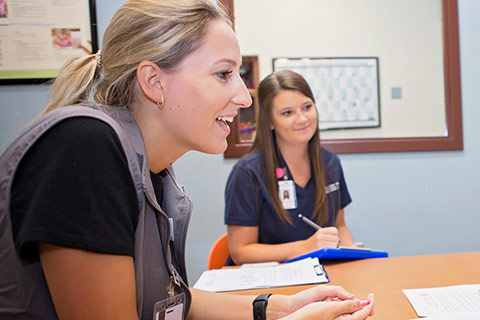
COVID-19 has permanently changed the way we live and work. In some cases, what was once necessary to keep us safe has turned into standard practice and occasionally added convenience. One example is through the change of how we receive health care.
Caroline Rickman ’21 experienced the new normal of health care firsthand by virtually completing her clinical hours through teletherapy.
"When COVID-19 started, I was sure that I would have more cancellations and an inconsistent schedule throughout my last clinical placement," Rickman said. "My mind immediately thought these cancellations would interfere with the clinical hours I need to obtain so I can graduate. I thought, ‘no way I will graduate on time.’”
With the help of faculty and staff at Samford, Rickman was able to continue coursework virtually and complete her clinical hours. During the initial few weeks that the world adjusted to the pandemic, Rickman said things slowed down.
"The first two weeks were the transitioning week for every company, so I did see a pause on my clinical hours," Rickman said. "However, once iPads were distributed to families from donating corporations and children could utilize their parent's computers, most families craved some sort of consistency with their child's care during this period."
According to Rickman, Samford prepared her to meet patient needs and be consistent in providing care. She said she does this by constantly supporting families by answering questions and providing consistent therapy.
"If I knew families did not have WIFI, I printed material and dropped it at their houses," Rickman said. To be a successful and impactful speech pathologist, clinicians must know how to adjust. There are so many educational online resources to utilize during therapy, and each client must have access to educational resources to improve.
Beyond the pandemic, Rickman sees teletherapy becoming a much larger part of the profession, especially in places with unpredictable weather.
"I currently reside in Colorado, so we experience snowstorms until May. Because of COVID-19, the client's family now has the choice to complete the session via teletherapy or in-person," Rickman said. "When it is dangerous outside, clinicians and families work together to complete a teletherapy visit. This easy transition for services will ensure clinician and family safety in the future."
Rickman says that teletherapy will always be an option if a family wants services. She also says that speech pathologists will have a more consistent schedule because of this alternative.
"Many companies are wanting to hire younger individuals straight out of graduate school because of new knowledge such as teletherapy," Rickman said. "I can truly and confidently say that Samford over-prepared me in the best way to be a speech language pathologist."
Samford’s Communication Sciences and Disorders department has begun to integrate technology that supports teletherapy into their training programs.
“Teletherapy has become an important part of service delivery and access to services,” said Carol Koch, professor and director of the speech language pathology program. “Graduate students need to be provided with opportunities to experience this model of service delivery. Because of our clinical model, Samford students received excellent training during their clinical experiences.”
